It’s almost the end of the summer and I realize that the professional development I have been in has been pretty fantastic, and pretty awful. I spent a good amount of time discussing about how we teachers can perfect our craft reaching at-risk students—a great goal. The difficulty is that defining an at-risk student can be hard.
We talked a lot about “those in poverty, those with gender issues, those with disabilities, and diverse students who struggle to have a voice and be accepted.” This makes sense. Yet not once this summer did I hear gifted and talented students mentioned as being at risk. Not once.
On some level, I get it. It took me nineteen years to fully understand that I had a gifted student in my own house who was at risk. But at 1:30 a.m., my son admitted he wanted to drop out of school.
After picking myself up off the floor, I spent a great deal of time trying to figure out what my husband and I could have done differently. After all, I teach gifted and talented kids. I differentiate my instruction. I work to meet their social-emotional needs. How could I have not identified the risk with my own son?
Perhaps it’s because, like many gifted kids, my son was good at hiding his struggles. But I also broke a rule I should have remembered. Doing well in school doesn’t mean a student is thriving, or even happy. “His grades are good,” I said to myself, “so he’s fine.”
I had to relearn some truths about gifted students to help my son, and I offer them as information for educators and parents of gifted students:
- Gifted and talented students are not the easiest kids to teach. Gifted students may grasp concepts faster, but they also move at a different pace. Sometimes this pace may be faster or slower depending on acceleration or depth and complexity in content. Additionally, many gifted students are twice-exceptional and have a disability which may require an Individualized Educational Plan (IEP).
- Gifted and talented students are not always the strongest students. It is easy to assume that gifted students can operate in a college and real-world setting academically, when in reality, structures are not in place to support their success. Gifted students need multiple ways to learn, and a traditional classroom in both K–12 and college settings may not be the best fit for them.
- Gifted students often need help maneuvering the world outside of school and need support emotionally. Social-emotional support for gifted students is key to their success. Many gifted students think like adults, but operate on an emotional level that is much closer to their age. Anxiety and depression is common, as is perfectionism. Without support, gifted students have a high dropout rate in both high school and college. Because of their fear of failure, and high levels of intelligence, they can easily hide their challenges until it is too late to support meaningful change.
Looking back, I realize it took great courage for my son to be brutally honest with me about his fear of failure, his need for differentiated instruction, and his anxiety about choosing a major. He realized that anxiety and depression had taken over his life at that time and he broke down, but he broke down to his parents.
Not all students are so lucky. This makes it even more important to support all of our at-risk students at school, including the gifted and talented ones who are often forgotten.
Michelle Pearson is the 2011 Colorado State Teacher of the Year and a member of the National Network of State Teachers of the Year. She is is a middle school social studies teacher in the Adams 12 Five Star School District in Thornton, Colorado, where she has been teaching for twenty-five years.
Editor’s note: This article originally appeared in a slightly different form on the Education Post.
The views expressed herein represent the opinions of the author and not necessarily the Thomas B. Fordham Institute.
